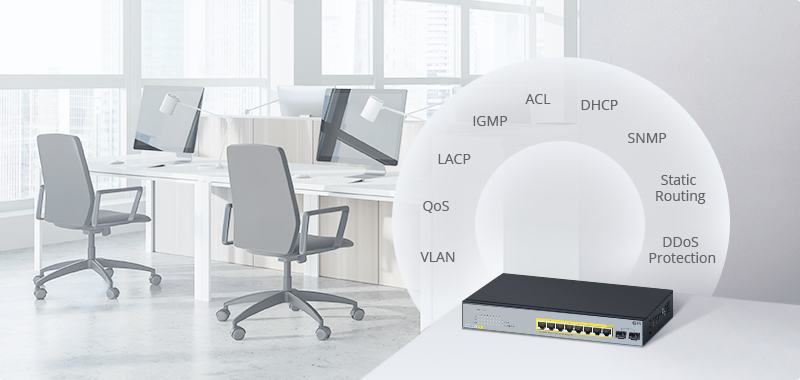Managed vs Unmanaged vs Smart Switch: What Are the Differences?
A switch is the core of a Local Area Network, it effectively connects devices on a specific LAN to ensure effective data transmission between devices on the LAN. There are three main types of switch: managed switch, smart managed switch and unmanaged switch. Managed vs unmanaged vs smart switch: how to choose based on your network deployment? This article will help you understand the three switch types and the differences.
Managed vs Unmanaged vs Smart Switch: Definition
What Is Managed Switch
Generally, Managed switches usually adopt SNMP protocols that enable users to monitor the status of the switch and its ports, allow you to readout throughput, port utilization, etc. Managed Ethernet switches are designed for high workloads, high traffic, and deployments that require custom configurations. In large data centers and enterprise networks, fully managed switches are often used as the core layer of the network, providing a wide range of tools and capabilities.
Note: S5860-20SQ now supports AC or DC power supply.

FIgure 1 : The S5860-20SQ, 24-Port Ethernet L3 Fully Managed Pro Switch
What Is Unmanaged Switch
Unmanaged switches are also known as dumb switches, as they are simply plug-and-play devices without remote configuration, management, or monitoring options. You cannot log in to an unmanaged switch, nor can you read any port utilization or throughput for the device. Unmanaged switches have a fixed configuration that provide Ethernet devices with network connections so they can communicate with one another.
Unmanaged switches are used in small networks or add temporary groups of devices to a larger network, to expand the number of Ethernet ports and connect network hot spots or edge devices in small independent networks.

Figure 2: The Plug-and-Play Unmanaged switch
What Is Smart Managed Switch
Typically, smart managed switches are managed through a Web browser, which enables users to maintain their network with intuitive guidance. These smart ethernet switches are especially suitable for enterprises that require remote security management and troubleshooting, enabling network managers to monitor and control traffic to achieve optimal network performance and reliability. Web Smart Managed Switches have emerged as a viable solution for SMBs, with the greatest advantage that you can change the configuration of the switch to suit your specific networking needs.

Figure 3 : Functions of smart managed switch
Managed vs Unmanaged vs Smart Switch: What Are the Differences?
In general, managed switches are capable of comprehensive network management and monitoring, support QoS, Web GUI, VLAN, etc. On the contrary, unmanaged switches offer no management capability at all and are very cheap. Smart switches fill a middle ground. They have some managed facilities and support for VLANs, but they lack some features compared to fully managed switches. For example, they typically lack a serial console port and some of them can only be configured through the Web interface.
The five key differences are the following:
| Features | Performance | Security | Cost | Application | |
|---|---|---|---|---|---|
| Managed Switch | Comprehensive functions | Monitoring and controling a whole network | High-levels of network security | Expensive | Data center, large size enterprise networks |
| Smart Managed Switch | Limited but intelligent functions | Intelligent manage via a Web browser | Better network security | Cheap | SMBs, home offices |
| Unmanaged Switch | Fixed configuration | Plug and play with limited configuration | No security capabilities | Affordable | Home, conference rooms |
Managed vs Unmanaged vs Smart Switch: How to Choose?
Selecting an appropriate switch type is based on network capacity and requirements for network management and security.
Managed switches are aimed at large professionally managed networks that need to manage and troubleshoot their network remotely and securely, allowing network managers to reach optimal network performance and reliability.
Unmanaged switches are ideal for home offices and uncomplicated networks, user just want to get the home network worked normally and do not want to spend much time on the management, then plug-and-play unmanaged switches are the best fit for them.
Smart managed switches provide a trade-off between cost and functionality. For SMBs or home users, who need visual network management and high network security while with limited budgets, a high-performance, easy to manage, stackable Web smart managed switch will be an ideal and cost-effective solution.
You might be interested in
Email Address

-
PoE vs PoE+ vs PoE++ Switch: How to Choose?
Mar 16, 2023














